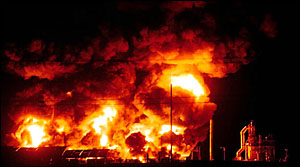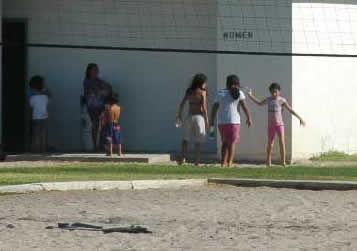^(Left) Daggett solar thermal plant explosion, 1999; notice the mirrors at lower left (Photo by Lara Hartley). (Right) Kids at park in Amargosa Valley by elementary school which would be less than 1 and 1/4 miles from the proposed solar mirror field of Solar Millennium's plan.
Explosion Dangers: Solar Industrial Projects and Schools Do Not Mix!
August 18, 2009 - Amargosa Valley, Nevada
That was the message of many residents at a Bureau of Land Management (BLM) scoping meeting in the town of Amargosa Valley, Nye County, Nevada. They were well organized and vocal about the dangers of having a huge industrial solar thermal project in the midst of their community on the flat desert along the Amargosa River, surrounded by public lands that are being increasingly snatched up for renewable development in a new land rush.
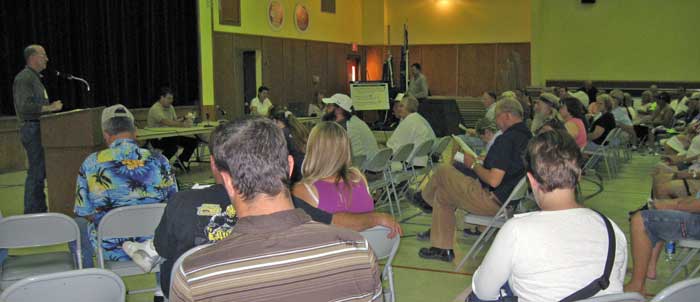
^Scoping meeting. The community center was crowded.
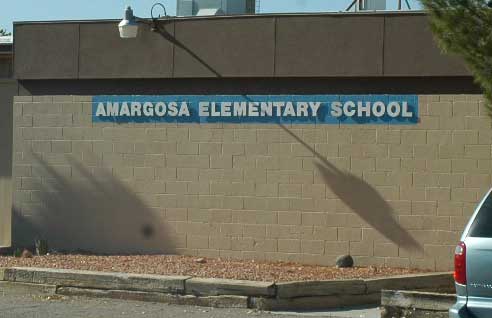
The German company Solar Millennium AG wants to lease 7,810 acres of BLM land that interfingers with the town, placing giant parabolic mirror fields with superheated oil (Therminol) on 4,350 acres, within a quarter mile of many homes, and less than a mile and a quarter from Amargosa Elementary School and a park. Two power blocks would also be within these fields, including two thermal storage tanks in each, containing molten salt - an experimental technology - as well as large steam turbine engines like those used in conventional fossil fuel plants.
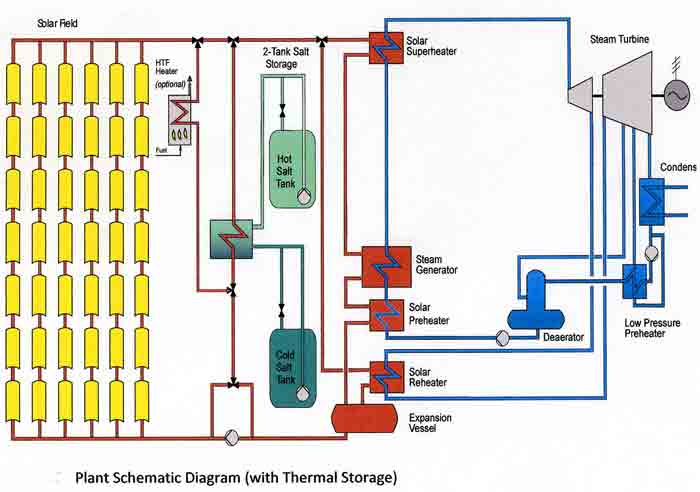
(From Solar Millenium's Plan of Development pdf)
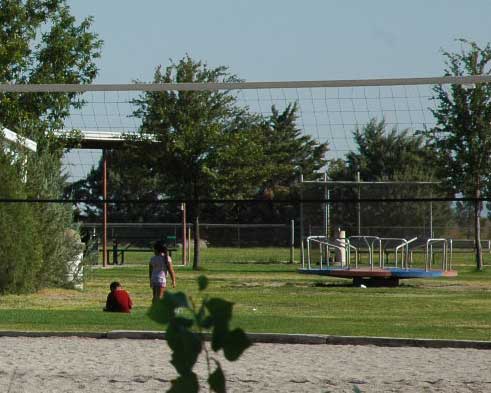
Many residents voiced concerns about explosion and fire dangers from such a power plant, citing the 1999 explosion at the Daggett SEGS Solar 1 plant . The SEGS 1 plant used new molten salt thermal storage technology developed in the 1980s, and initially had 3 hours of thermal energy storage that was used to dispatch to peak period. But the storage system was damaged by an explosion and was not replaced (source: National Renewable Energy Laboratory -http://www.nrel.gov/csp/troughnet/power_plant_data.html). (See below.)
This plant had a nameplate maximum capacity of only 13.8 megawatts (MW). Solar Millennium is seeking 242 MW. The heat transfer fluid Therminol will be used in Solar Millennium's design, similar to the Caloria oil that burned uncontrollably all night at SEGS 1. Pipe ruptures in the parabolic trough fields are a hazard.
Several residents stood up to speak about how the local volunteer fire department would not be able to handle an oil spill or fire involving specialized chemicals. Who will supply the needed equipment to cope with this industry? One man said a quarter-mile buffer zone was needed between the plant and residences at least. Questions were raised about how to evacuate the school in the event of a fire at the solar plant. Someone commented that he doubted that the execs of Solar Millennium would live so close.
Also, some pointed out that the mirror construction area was right across the street from the school, and surrounding a park: how much truck traffic would be going on the school road? Will kids be hit? "Why here?" the person demanded to know.
The draft Environmental Impact Statement will be out after January 1, 2010, according to Greg Helseth, BLM Renewable Energy Project Manager
"There is a political frenzy to rush these plants for the economy, but at what cost?" asked an audience participant. "We are not guinea pigs. Maybe BLM did not realize that homes were so close, we urge you to find a way to move this plant," the person said, addressing the BLM managers. "We need solar power, but just not in our yard!"
A resident who told us she lived a mile from the proposed plant handed out sheets with photos of the explosion at Daggett, and had a color poster with comments, but she was not allowed to show the poster during the proceedings of the meeting.
One man reminded the panel that Amargosa Valley was developing an area plan that called for a quiet, rural place.
Jan Cameron, chairman of the Amargosa Town Board, stood up and explained that the area plan was approved after two years work on it. She would like to see some solar development north of Frontier Road, to bring jobs and energy, but the safety of people needed to be considered. "A lot of an EIS is bugs, bunnies and bushes and not so much the human concerns." There would also be many infrastructure impacts to town, as well as the issue of water, she said.
A 33-year resident declared, "I love this desert," but went on to say how there seemed to be more protection for pupfish than for people. The crowd applauded strongly.
The brochure describing Solar Millenium's Andasol 1-3 plants in Spain, similar to the Amargosa Valley proposal, states, "No residential buildings are located adjacent to the site of the power plant" (source: The Parabolic trough power plants Andasol 1 to 3: The largest solar power plants in the world -- Technology premiere in Europe, pdf, page 10). This was apparently a concern in Europe -- why not in the U.S.?

^School and creosote desert beyond that would be the solar field of Solar Millennium's development.
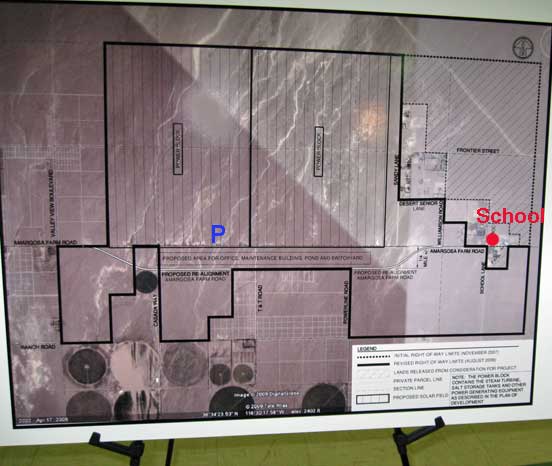
^The applicant Solar Millennium had this poster at the scoping meeting, showing a revised project boundary. The mirror fields lie less than 1 and 1/4 mile from the school, park, senior center, and community center. Irrigated fields lie to the south of the project, and homes scattered throughout the area. P = photo location below.
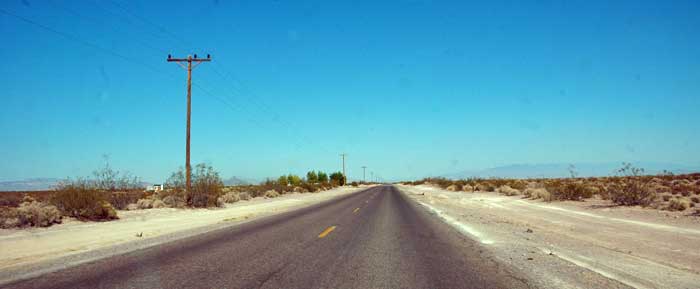
^Amargosa Farm Road now, at location marked P on map above, driving eastbound. Under Solar Millennium's plan this would be rerouted and the area used for offices and buildings next to the solar field to the left in the photo.
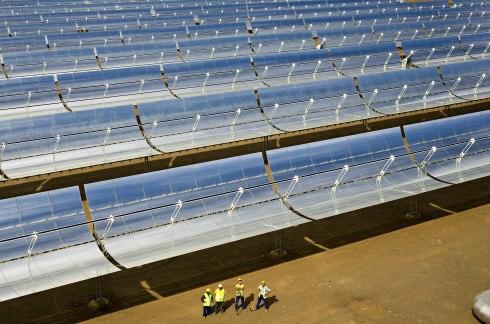
^Solar field: giant parabolic mirrors 30-feet across of Andasol 1, Solar Millennium's test plant in Spain which they will imitate in Amargosa Valley if permitted.

^Home next to the proposed solar field.
Many residents of Sandy Lane spoke up. One woman told how they were right across the street from the project. "We feel like we're in the way of Solar Millennium," she said. She explained how the company could have chosen any area around the valley when they filed in 2007, but chose to locate right in the middle of town. They developed their plan in secrecy, and did not share it until May 2009 (see our report on this meeting >>here). Another resident pointed out how BLM had a backlog of applications for more solar projects, that filled thousands of acres of the valley, so it would be difficult to relocate.
Las Vegas BLM Renewable Energy Project Manager Gregory Helseth confirmed that he was dealing with 57 applications in Nevada, trying to dissolve ones when the companies were no longer interested. He will be meeting with CoGentrix soon, he said, to work on reducing their application number. Yes, he agreed that Solar Millennium was "locked in" by CoGentrix to the north. But he explained that BLM recieves "memos from Washington" telling them they cannot stop accepting applications.
"It will be an eyesore right in the middle of town," a resident said.
Another Sandy Lane resident explained how the project would also be right across from her porch, where she sits in the morning with coffee, watching the colors of the sunrise on the mountains. If Solar Millennium gets approval to build, she would instead see the glare of mirrors. "It should be five miles out!" She was also concerned about the heat and dust from "our horrendous winds out here." She said the church was also on the boundary of the project. "This is home, this is life." Several people clapped.

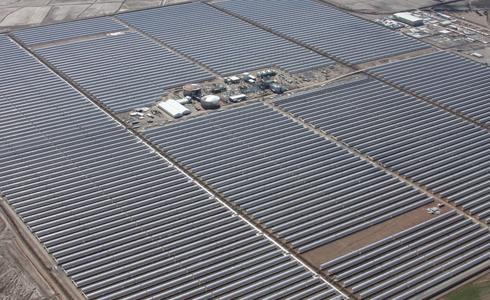
^Andasol 1, Spain, the first parabolic trough power plant in Europe generating electricity since December 2008.

^BLM land with open desert interspersed with private land.
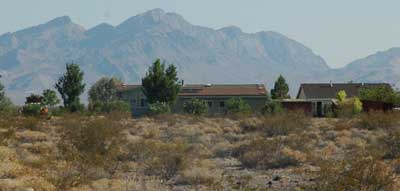
^Residences next to the project boundary.
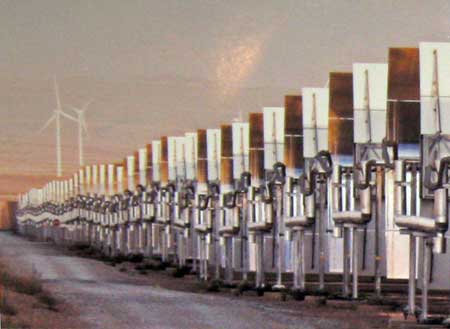
^Parabolic trough field.
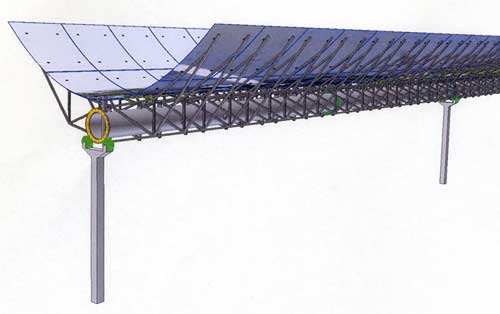
^Parabolic trough mirror (from Solar Millennium's Plan of Development pdf).

^Park across from school along Amargosa Farm Road, which will become the main entry point for trucks delivering building materials for Solar Millennium's proposed energy development.

^Elementary school along Amargosa Farm Road, in the path of industrial solar.
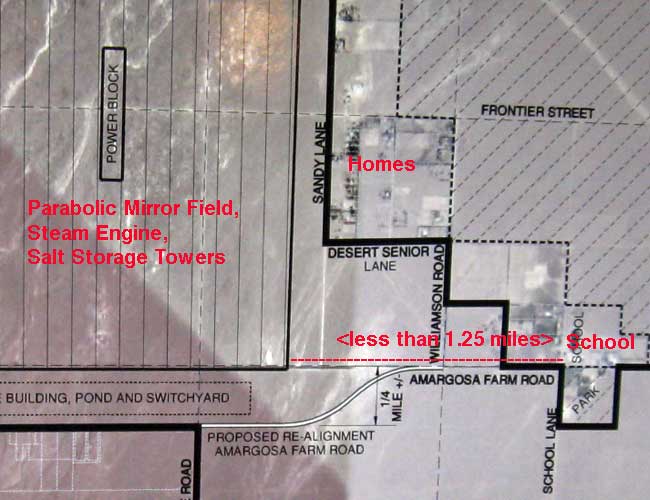
^Too close for comfort: homes and school near power plant that will use superheated hydrocarbon oil, molten salt, and other chemicals, some quite toxic. The park across from the school will be surrounded by a maintenance yard and pre-construction area.
Water, Dust, Impacts to the Town
Other concerns raided by audience members included dust control, flooding of Forty-mile Wash that crossed the proposed solar field, harmful chemicals getting into the groundwater and drinking supply, and will Valley Electric raise rates when required to buy this new electricity? Another question pointed to how Arizona BLM has forms that the public can send in to recommend previously disturbed areas and brownfields to site solar and wind developments so that pristine desert habitats are not destroyed -- Nevada BLM should consider similar programs.
Mr. Guerra, a 30-year resident of town said Solar Millennium should pay it's way in Amargosa Valley, as it impacts the roads and services. The company should help pay for upgrades to the fire station, medical clinic, Beatty High School where students bus to. Other residents had voiced concerns over the size of the project overwhelming Amargosa Valley. Will Solar Millennium be busing in a workforce? asked one man. He pointed out that often the original understanding of the company with a community is not passed on when the company is sold. Guerra also told BLM it needed to put out a Spanish translation of the plan so that the many Spanish-speaking workers in the community could better participate in the process.
Brian Brown, running the China Ranch date farm downriver in Tecopa, California, came to represent of the Amargosa Conservancy. He pointed out that a wet-cooled system that Solar Millennium wants for its solar plants is not sustainable in this region, "one of the driest places in the nation, in a basin already in overdraft." There are threatened and endangered species along the river -- a "world-class" suite of species." This project would be the first on the way to making the whole valley a huge industrial zone, of 60,000 to 70,000 acres. The environmental effects of this would go on for hundreds of years. If this amount of desert were scraped, the dust problem would be negative, he said. Many in the audience applauded.
A retired Vegas Valley Water District employee and resident of the nearby town of Crystal added that contaminated groundwater from the atomic test site to the northeast was flowing faster than expected, during recent test measurements. It has not yet left the test site boundary, but the man wondered if high-production wells were put in at Solar Millennium's site would increase the movement of this water toward town. "Use wind, save our most precious resource -- water," he said.
Tribal Concerns
The Timbisha Shoshone Tribe was represented by Barbara Durham. "It seems like yesterday we were having to protect our rights and our land, and here we are again," she said, referring the proposed Yucca Mountain Nuclear Waste Repository in an arm of the valley about 20 miles to the northeast.
The Timbisha have a trust parcel of land south downriver at Death Valley Junction, so they are quite concerned about the water usage of Solar Millennium's plan. "I will say our tribe is in favor of alternative energy, but I think we're going to have to support the people of Amargosa Valley on how this is going to affect them and us down the road," Durham said.
This area was used by the Shoshone and Southern Paiute, so they also had issues with potential cultural sites on the project area.
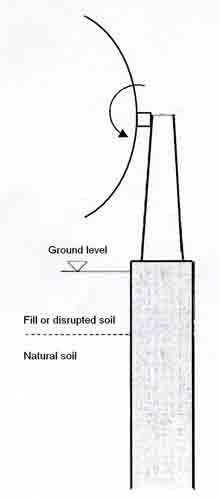 Durham scolded the BLM about how the government agency said it was in consultation with tribes over the project. "We haven't talked at all, haven't even begun consultation with BLM," she told BLM representatives on the panel. "We have a government-to-government relationship with the BLM, " she pointed out. "We need to start talking."
Durham scolded the BLM about how the government agency said it was in consultation with tribes over the project. "We haven't talked at all, haven't even begun consultation with BLM," she told BLM representatives on the panel. "We have a government-to-government relationship with the BLM, " she pointed out. "We need to start talking."
Durham also said that clearing the ground for the project is a concern for the Tribe, as well as loss of plants and animals on the desert. "A lot of residents have talked about the eyesore this is going to cause and the heat that's going to radiate from it. I'm not sure how that's going to go, but I'm sure it's going to be a problem in the future."
Supporters in the Minority
A few people in the audience were for the proposal, citing potential jobs. Funeral Mountain Ranch owner Bill DeWit voiced his support. "I own a lot of property south of Farm Road, right next to the plant." He did not mind the close proximity. "The economic impact will be beneficial to the valley," he went on. "Kids go to university and don't come back here. We need projects like this for economic development." Several people clapped.
Darrel Lacey, a Nye County representative, also read a statement supporting Solar Millennium on the grounds that it
^Cement foundation of parabolic mirror, buried in the ground, with surrounding soil bare (from Solar Millennium's Plan of Development pdf)would increase jobs and tax revenues. He said the county would work on addressing the water issues, fire response, dust control, and buffer zones and fences next to residences.
Also see story in the Pahrump Valley Times >>here.
Explosion Dangers of Solar Thermal

<The fire still smolders and burns more than 14 hours after it started. (Photo by Lara Hartley)
From the National Renewable Energy Laboratory:
SEGS I
Location: Mojave Desert, Daggett, San Bernardino County, California.
First Year of Operation: 1985
Type: Solar electric generating station (SEGS) with parabolic troughs; solar steam generation with natural gas superheating, including three hours of thermal energy storage.
Fossil fuel: Natural gas Net Output: 13.8 MW
Principals: Sunray Energy, Inc. (owner/operator), Luz (developer), Southern California Edison (utility PPA).
Solar Technology: Luz LS-1 and LS-2 collectors
Project Type: Public Utility Regulatory Policies Act (PURPA) Qualifying Facility IPP with special Standard Offer 2 (SO-2) type power purchase agreement to Southern California Edison.
Operational Dispatch: Solar operation during sunny hours. The plant initially had 3 hours of thermal energy storage that was used to dispatch to peak period. The storage system was damaged by fire in 1999 and was not replaced.
Special Incentives: Federal and state investment tax credits, solar property tax exclusion, accelerated depreciation.
Status: Daily operation. The two-tank thermal energy storage system used mineral oil (Caloria) heat transfer fluid to store energy for later use. It operated between 1985 and 1999.
SEGS II
Location: Mojave Desert, Daggett, California
First Year of Operation: 1986
Type: Solar electric generating station (SEGS) power tower; solar steam generation and solar superheating; auxiliary natural gas boiler to provide backup capability during low and non-solar hours.
Fossil fuel: Natural gas Net Output: 30 MW
Status: 2009 being dismantled and no longer in use (Barstow Daily Dispatch >>here).
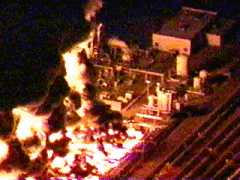
<The SEGS 1 fire burning high temperature oil used to transport heat from the troughs to a thermal storage tank. There have apparently been TWO FIRES here. One fire was caused by a natural gas problem in the power block; an earlier fire was due to over-heating the oil (human error) and was caused by a trough tube leak (according to Red Rock Energy, http://www.redrok.com/helio.htm)
In February 1999 a massive explosion shook the plant and surrounding area. It was just a few miles from photographer Lara Hartley's place, and she drove over to take pictures (see http://www.digitalstoryteller.com/BTV99/hartley/0303.shtml). She reported that 900,000 gallons of mineral oil burned. "Huge flames and black clouds roiling into the night sky," she wrote. Firefighters had to wear gas masks to avoid the toxic fumes.
Solar Millennium will use a new higher temperature heat transfer fluid — a eutectic mixture of biphenyl-diphenyl oxide (Therminol VP-1 or Dowtherm A). In recent years, a new indirect thermal energy storage (TES) approach has been developed. This approach takes advantage of the experience with the storage system used in the Solar 2 — a molten-salt power tower demonstration project — and integrates it into a parabolic trough plant with the conventional heat transfer fluid through a series of heat exchangers. The thermal energy storage system is charged by taking hot, heat transfer fluid (HTF) from the solar field and running it through the heat exchangers. Cold molten-salt is taken from the cold storage tank and run counter currently through the heat exchangers. It's heated and stored in the hot storage tank for later use. Later, when the energy in storage is needed, the system simply operates in reverse to reheat the solar heat transfer fluid, which generates steam to run the power plant. It's referred to as an indirect system because it uses a fluid for the storage medium that's different from what's circulated in the solar field.
Several parabolic trough power plants under development in Spain plan to use this thermal energy storage concept. For future parabolic trough power plants, a number of alternative approaches are being considered for reducing the cost of the thermal energy systems. A two-tank indirect thermal energy storage system is relatively expensive — its primary disadvantage. The expense is due to the heat exchangers and the relatively small temperature difference between the cold and hot fluid in the storage system (source: National Renewable Energy Laboratory).
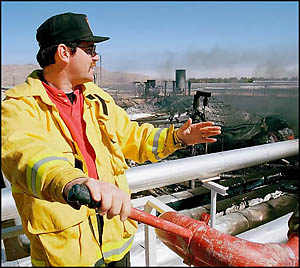
^A fire investigator looks over the burned out remains of the fuel tanks (Photo by Lara Hartley)
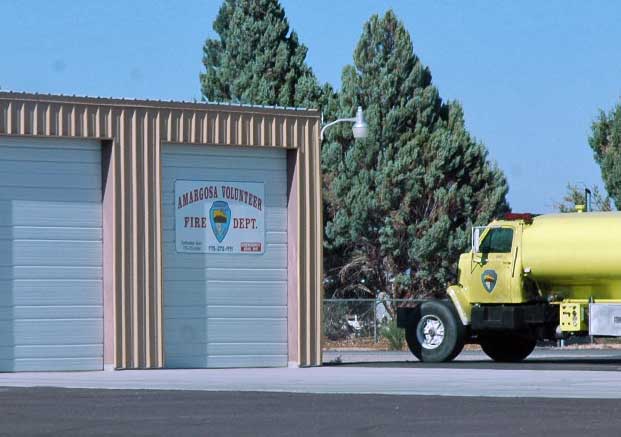
^Amargosa Valley's volunteer fire department. Residents say this would not be able to handle chemical fires of the type that Daggett experienced.
Material Safety Data Sheet (source: www.energy.ca.gov)
Product name: THERMINOL® VP1 Heat transfer fluid, synthetic oil in the pipes collecting heat from the parabolic trough reflectors.
FIRE FIGHTING MEASURES:
Fire point: 127 C
Hazardous products of combustion: carbon monoxide (CO); carbon dioxide; hydrocarbons.
Extinguishing media: Water spray, foam, dry chemical, or carbon dioxide.
Unusual fire and explosion hazards: None known.
Fire fighting equipment: Firefighters, and others exposed, wear self-contained breathing apparatus. Equipment should be thoroughly decontaminated after use.
Miscellaneous advice: This product is not classified as a fire-resistant heat transfer fluid.
Precautions to avoid sources of ignitions should be taken. Precautions against ignitions and fire should be taken with this product. Chronic exposure has been reported to cause headache, fatigue, nausea, indigestion, abdominal pain, tremor, central and peripheral nerve damage and liver injury.
Environmental Toxicity to Fish: Rainbow trout (Oncorhynchus mykiss) 7.6 mg/l (lethal);
Fathead minnow (Pimephales promelas) 24 mg/l (lethal).
DISPOSAL CONSIDERATIONS:
US EPA RCRA Status: This material when discarded may be a hazardous waste as that term is defined by the Resource Conservation and Recovery Act (RCRA), 40 CFR 261.24, due to its toxicity characteristic.
--------------------------------------------------------------------------------------------------------
Department of Energy Sandia Laboratory Tests on Therminol:
(Source: THERMOCLINE THERMAL STORAGE TEST FOR LARGE-SCALE SOLAR THERMAL POWER PLANTS, publication on U.S. Department of Energy, Office of Scientific and Technical Information:
http://www.osti.gov/bridge/servlets/purl/761869-hh1dP8/webviewable/761869.pdf)
"[Image] Solar Two, an example of a Central Receiver Solar Power Plant. Central receiver power plants, often referred to as power towers, use molten nitrate salts as their heat transfer fluid. Surrounding the tower are thousands of slightly-concave sun-tracking mirrors called heliostats. The receiver is located at the top of the tower. All the heliostats reflect and concentrate the sunlight onto the receiver. At Solar Two the molten salt experienced temperatures between 290°C and 560”C. Solar Two was a 10MW, test solar power plant that was connected to the power grid in Southern California. Southern California Edison (SCE) was the head of a consortium of utilities that demonstrated Solar Two with SNL and the DOE. Solar One was the first large-scale central receiver power plant to be constructed and tested. It was located at the same site as Solar Two. The difference was Solar One used a water-steam receiver and an oil-rock thermocline storage system. Solar Two substituted molten salt as the heat transfer fluid instead of water and also molten salt as the storage medium instead of the oil.
"[Image] Solar Energy Generating System (SEGS) four through seven, an example Parabolic Trough Solar Power Plants. These plants are more commercial than central receiver power plants. In the mid-1980s SCE signed a thirty-year contract to buy electricity from nine SEGS plants that would be constructed. An Israeli company called Luz developed the majority of the technology for these parabolic trough power plants. SNL did some supportive testing.oday these plants are connected to the utility power grid and serve tens of thousands of homes and businesses in Southern California. Construction of the SEGS power plants began in the mid-1980s and finished in the early 1990s. [Image] Heat Collection Element (HCE), a sun absorbing tube.The heat transfer oils travel through this tube and heat up due to the concentrated sunlight. These plants consist of many rows of parabolic-shaped mirrors to concentrate sunlight onto a tube that runs along the focal point of the mirrors. Temperatures in SEGS Two-Nine reach 390”C, and the heat transfer fluid is a synthetic oil called Therminol. In SEGS One a mineral oil called Caloria is used as the heat transfer fluid.The SEGS One plant runs its power cycle at temperatures of 220°C and 310”C. In SEGS One there are two tanks that provide some storage for the power plant. These two tanks house the heat transfer fluid, Caloria. In SEGS TWO-Nine there is no storage because Therminol can reach higher temperatures than its Caloria counterpart at SEGS One. The power cycle temperatures at SEGS Two-Nine are 290”C and 390”C. The higher temperatures yield a higher efficiency in the steam turbine. Additionally the Therminol boils at 260°C and atmospheric pressure. Thus, it must be pressurized. The cost of a pressurized storage tank is not practical in the SEGS Two–Nine plants.
"Solar Two used a two-tank system. There was a hot tank 560”C filled with just molten salt, and a cold tank containing molten salt at 290”C. The molten salt was used in Solar Two because it can reach higher temperatures than the mineral oil, Caloria, used in Solar One. The molten salt can reach 560°C whereas Caloria’s peak temperature is 310°C. A higher temperature yields a more efficient cycle, thus the substitution of molten salt for mineral oil made sense. One of the largest challenges for large-scale solar thermal power plants taking off commercially is their large cost compared to the cost of conventional power plants such as coal. Currently, the average coal power plant produces electricity for a cost of $0.02-$0.04 per kWh. Solar power plants produce electricity for a cost of $0.12 per kWh....
"Salt/Oil Safety Test: This test explored the reactivity between Therminol and Caloria, and the molten nitrate salt. The molten salt used in this test was a commercially available mixture of 48% CaNOs, 7% NaNOs, and 45% KNOS. Its freezing point 87°C – 130”C. This mixture is sold under the name Hi-TEC XL. The composition of these molten nitrate salts can be altered without much change on its material properties. For example, this Hi-TEC XL would behave very much the same in metal heat treating processes as would a mixture with different concentrations of CaNOs, NaN03, and KN03. The factor that varies with changes in the concentration of the constituents is the melting/freezing temperature .Therminol and Caloria are currently used as the heat transfer fluids in the SEGS solar trough power plants in southern California. Therminol is a synthetic oil; Caloria is a mineral oil. Since the intention of the thermocline is to provide thermal storage for the Solar Trough power plants, we needed to investigate the reactivity between the oils used in the SEGS plants and the molten salt. It is possible that the oils could come into contact with the molten salt at the operating temperature of 400”C due to a failure in the oil-to-salt heat exchanger. The subsequent reaction could cause a dangerous result such as a fire or explosion.
"The Therminol caused rapid bubbling and steaming when introduced into the salt. Bubbling continued for one minute and twenty seconds until the Therminol was completely boiled off. The bubbling is desirable because a failure in a Therminol-to-salt eat exchanger could be detected with a sensing mechanism that identifies a pressure rise. There were no flames.The Caloria caused similar result as the Therminol. It bubbled and steamed for three minutes before all the Caloria was boiled off. Again this was satisfying because we witnessed no flames or explosion. After the Caloria boiled off we surrounded and covered the beaker with insulation in order to maintain the temperature of the salt at 400”C for the next experiment. Immediately upon covering the beaker we saw flames seeping through the gaps in the insulation. Right away we removed all the insulation from the beaker. The surface of the salt maintained the flame for just over two minutes.The flames we saw in the Salt/Caloria safety test motivated us to repeat the salt/Therminol safety test, but this time implementing a spark plug in the headspace of the beaker. The Caloria vapors, mixed with oxygen from the air, caught fire when trapped by the insulation. Perhaps the Therminol would have reacted the same way had it been covered in its original test. The objective of this test was to determine if containing Therminol vapors and providing a spark would cause the vapors to ignite.The Therminol vapors did ignite. Thus we deduced that if the temperature is above the boiling point of the oil (260°C for the Therminol and 320”C for the Caloria), then oil vapor will be present. If this vapor is contained and oxygen is available, then the oil vapors can ignite. If salt storage systems are to be incorporated into the Solar Trough power plants, care should be taken to monitor the oil-to-salt heat exchanger in case of a leak. A fire could result. One positive note was that both the Salt/Therminol and Salt/Caloria safety tests showed no signs that an explosion would occur. The flames in both tests ceased after a few minutes. The oil vapors just needed to burn off."
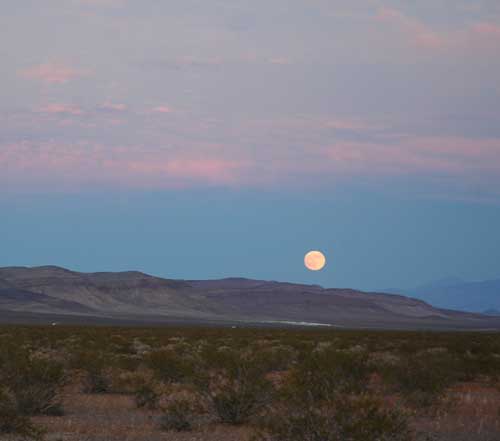
^Full moonrise over Amargosa Valley.
August 28, 2009: Solar Millennium responds to concerns over water and explosion dangers >>here
HOME.....Solar Millennium May Meeting.....Hand-out on Dagget Explosion
